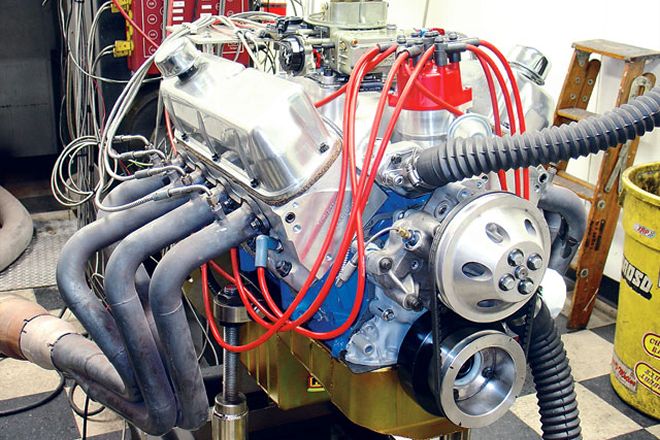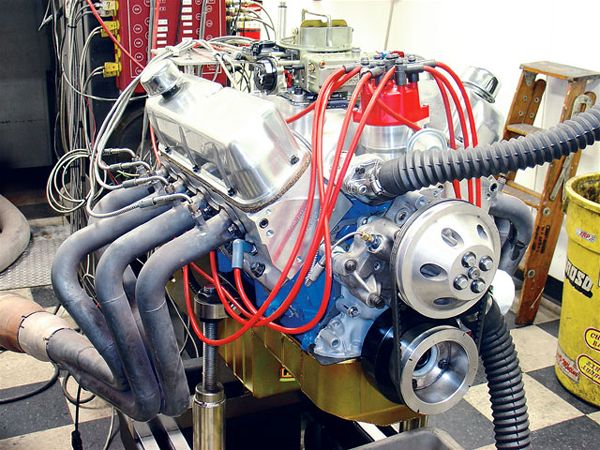

Building an off-road powerplant is not something you'd want to approach in the same way as a drag-carengine, though many of the mods developed for the street are applicable in the dirt. The '66-'77 Ford Bronco with its 289 or 302 engine endures as an all-time favorite in the world of off-road performance. But what to do when the old girl is tired, other than put her in a barn? Adding the extra weight and mass of bigger tires, wheels, and other accessories means the old 140-200 horse engines just don't cut it as well in today's wheeling world, so a proper upgrade is in order. Popular options include a simple rebuild or even an engine swap to a 351W (Windsor) but the basic 302 can really be made to perform with some relatively simple modifications, without the headaches of swapping in something different.
In an off-road environment, the stroker approach is a virtual bulls-eye, directly contributing to one of an engine's most important assets, torque. Stroker kits increase the displacement by increasing the piston's length of travel in the bore, which means that the pistons will move further up at the top of the crank's travel, and drop lower at the end of the cycle. Stroker engine packages were developed to infuse a healthy doping of displacement, and with this cubic capacity came torque and the ability to further stretch power output without resorting to unmanageable rpm. These stroker recipes are well proven, with the most popular for the 302 being a 0.400-inch stroker to create a 347. The 347 stroker uses pistons with a much shorter compression height, 1.090-inch, compared to the stock 302's 1.600-inch. Part of the reduction in piston height is to accommodate longer aftermarket 5.400-inch rods, a substantial increase from the stock 5.080-inch pieces. The longer rods provide two key benefits-more counterweight clearance for the long-stroke crank, and an improved rod ratio, decreasing the side loading of the cylinder wall that would otherwise result from the hefty stroke increase. There's quite a bit of science in these combinations, but fortunately the heavy calculus is already figured out, with compatible parts on aftermarket shelves ready to go.
When contemplating a stroker rebuild remember that the engine will be gutted of its original internals, including the crank, rods, and pistons. In a major rebuild the pistons are goners anyway, so the ante really consists of the crank and rods. Here the opportunity isn't just gaining displacement, but making a major move towards bulletproof. At the end of the process, not only will the engine grow some 40-plus cubes, but that 30-year-old cast crank and those spindly stock rods can be upgraded with serious hardware.
The goal for this engine build is to make good power and torque up to about 6,000 rpm, which is plenty to let the engine pull strong power numbers, but not so high that reliability becomes a concern. The plan also included a moderate cam profile, for reasonably good idle quality and low-end response. These factors, along with the moderate compression ratio, substantially define what the temperament of the engine will be. The bulletproof factor started with the bottom-end stroker components. This is the heart of the rebuild, so heavy duty was imperative. We selected premium forged KB pistons, a Scat's 4340 forged crank, and Scat 4340 H-beam rods. The pistons are the 16.5cc dished version, rather than the flat tops, to drop the compression ratio to 9:1, which allows running on regular pump gas found off the beaten track. Other more economical alternatives that can be considered are KB's hypereutectic pistons, Scat's I-beam rods, and Scat's cast-steel cranks, all three of which are far tougher than the stock internals.
When designing an engine, consider the entire combination as a whole. With the bottom end set, the camshaft profile was selected based on what is appropriate for the rest of the package. Going too far in duration will make low-rpm operation ragged, while not enough cam might clip the peak power unnecessarily. Also, the original 302 engines were equipped with hydraulic flat-tappet cams. Later 302 engines were revised to accept hydraulic roller cams. A hydraulic roller can provide more longevity, particularly if high-rate valve springs are employed for better high-rpm control. Durability is good; but better still, a hydraulic roller typically provides greater lift at a faster rate than a flat-tappet of similar overall duration. The result is more area under the lift curve, for more torque and power with a given level of cam.
Though late-model factory hydraulic roller equipment will not readily interchange in an early block, the aftermarket has hydraulic roller-cam retrofit kits made to do just that. We went with a Competition Cams Xtreme Energy XR276RF-HR, delivering 224/230-degrees duration @ 0.050-inch and 0.513/0.513-inch valve lift, on the intake and exhaust lobes respectively. This was about the limit of how radical we would go in an application like this, and in the end it seemed to strike just the balance we were looking for. Along with the camshaft, the valvetrain was upgraded, with new Competition Cams Pro-Magnum roller rockers, in the stock 1.6:1 ratio, and a set of Comp hardened pushrods. Once set up, this is a combination that will give years of rugged service.
While the stroker is pretty much a home run as an upgrade during a performance 302 buildup, particularly when weighed against the cost of reconditioning the original parts, other areas of the engine can also use some improvement. The stock heads are generally lacking when performance is the goal, and with an increase in displacement, this shortcoming will become even more acute. A hot 302 is definitely struggling for air with factory iron heads, so it only stands to reason that a 347, with 15 percent more displacement to feed, will be suffocating. Here it isn't too difficult to eclipse the OEM heads, which flow in the neighborhood of 155-160 cfm on the intake and about 110 cfm on the exhaust. With the variety of serious race hardware available, the temptation here is to go wild, but remember, we're not building a drag-race engine.
Within those constraints, we were looking at heads with a moderate port size, and strong flow within the lift range of the cam. Huge cfm numbers mean nothing if they happen well past the highest valve lift the cam will deliver. We selected Holley's SysteMAX No. 300-575 heads, which have a moderate intake port volume of 165 cc and flow 228 cfm at 0.500-inch lift-just about at the upper reaches of the cam. The heads represent a flow improvement of 43 percent over the stock pieces, more than enough to satisfy our goals.
For cost, ease of field diagnostics, and simplicity, we wanted to retain a carbureted induction. Here the first choice revolves around the manifold. There are manifolds of every imaginable configuration for 302 Ford-based engines, but for this type of application a single four-barrel is the natural choice. The major manifold decision is between a single or dual plane. In the rpm range of this engine, dyno testing consistently proves the dual plane to be the right configuration, with the long runners and 180-degree firing separation really being an advantage through the bottom and mid range. A Weiand Stealth manifold is a nice piece to do the job.
As for the carburetor, Holley has just the line to do the job with its Truck Avenger series. These are specially modified versions of the traditional performance carbs, built with off-road service in mind. Tech highlights include a special vent tube to prevent fuel spill-over, spring-loaded needle and seat valves for improved fuel inlet control, and a special metering block that prevents flooding even in extreme situations, up to a 40-degree approach angle, a 30-degree departure, or a roll. That's damned near any way but upside down. These carbs come in three sizes, from 470 to 770 cfm, and we went for the big one. The vacuum secondaries, and the Bronco's relatively light weight, go a long way to making such a large carb useable in this combination.
Those are the basics of how we arrived at this engine setup. With everything pondered over and thought out to the best of our ability, it was up to Speed-O-Motive to build it and then test on the dyno to prove its worth. We were on hand as Speedo's dyno operator Jake Harriston loaded the brute to the DTS pump, dialed in the baseline settings, and sparked it to life. With the open dyno headers, the 347 sounded sweet, settling into an idle that left no doubt that this was a bad boy. After an agonizingly long 30-minute run-in, we were ready for some noise with the imminent power pulls. With the torquey 347 topping the 400 mark in both horsepower and torque on the SAE scale, this thing more than doubled the factory gross power numbers. This kind of power is enough to stampede any Bronco.



















